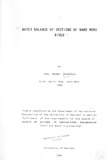| dc.description.abstract | This water balance study is directed towards the solution
of problems resulting from the utilization of river water
resources for domestic purposes and for irrigation by
·small-scale farmers living on the semi-humid to semi-arid
footzone and the semi-arid savannah regions of Naro Moru
river basin and its effect on the residual discharge
reaching river Ewaso Ng'iro. The study was carried out in
two reaches of Naro Moru river located in the footzone and
savannah areas of the basin.
The study entailed making an inventory of water supply
points along Naro Moru river, determining the amount of
water abstracted from each water supply point over a period
of six months, comparing the actual abstractions with the
authorized abstractions, measuring river discharge at the
river gauging stations marking the ends of each reach, and
using a river reach water balance to estimate groundwater
inflow into reach, transmission losses within reach and
direct runoff contribution to reach. The aim of the study
was to find out how streamflow is affected by each of the
factors mentioned above as a prerequisite for recommending
ways of improving the water allocation and management.
On a monthly basis, the amount of water abstracted from
each reach as a percentage of river inflow into reach was
about 10 % in the foot zone and savannah during the short
rains season (November and December) and rose during the
dry season up to 35 % in February and 47 % in March for the
footzone and savannah reaches respectively. Community water
supply projects which increased by four over the six year
period from 1984 were responsible for about 97 % of the
water abstracted from the river. Authorized abstractions
constituted about 8 % of the measured dry season
abstractions p.nd 30 % of the measured wet season
abstractions.
During the short rains in November and December, the
footzone river reach received additional flow from
groundwater sources and from direct runoff while the
savannah river reach lost water on transmission possibly
due to infiltration into the riverbed and sides during high
flows. Release of groundwater into the foot zone river reach
continued into the dry month of January and transmiss ion
losses for both reaches were lower over the ensuing dry
season (January to March). The long rains season resulted
in the addition of direct runoff into the two reaches but
the effect was more pronounced in the savannah than in the
footzone. This may be explained by the fact that the soils
in the savannah region swell on wetting thus reducing the
rate of infiltration while those in the footzone have
generally higher rates of infiltration.
Proper assessment, allocation and management of the
available river water may be achieved by installing simple
structures to measure the amount of water diverted
especially at the head of community water supply conveyance
systems, maintaining a stricker control over the issuing
and renewal of water permits and improving the efficiency
of water use. | en |

